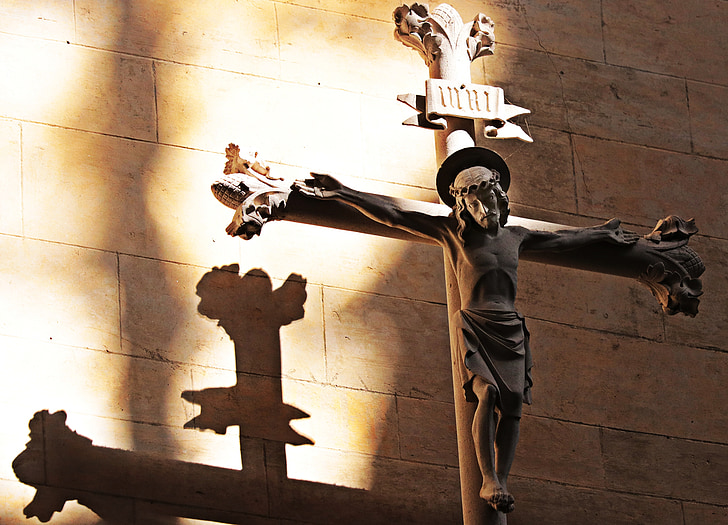Because of the symbolism of Ancient Egyptian Solar Worship ingrained in Jesus’ mythology, which suggested that Jesus was the Sun incarnate, Jesus was revered as a Sun God.
This section delves into the rationale for Jesus’ classification as a Sun God and his place in the larger scheme of mythology and religion.
Also Read: How Africans Were Lured into the First Slave Ship’ Jesus of Lubeck
First and foremost, the fact that Jesus is frequently shown with a sunburst behind his head, signifying his divinity, makes him a Sun God.
This is evident in the way that Jesus is frequently portrayed in art and architecture, where he is surrounded by a halo of light.
The Sun and its rays are represented by this halo.
Because Jesus is associated with light, he can thus be seen as a Sun God. This explains why followers of Jesus are supposed to get truth and enlightenment, earning him the nickname “Light of the World.”
In the same way as the Sun dispels darkness, Jesus also dispels uncertainty and ignorance.
Furthermore, Jesus is shown as bringing light into darkness in a large number of the Bible’s accounts about him.
For instance, the sky was said to be full of brilliant stars at the time of his birth. And after three hours of darkness following his crucifixion, light returned to the globe as Jesus rose from the dead.
Another common nickname for Jesus was the “Sun of Righteousness” (Malachi 4:2). In Revelation 22:16, he was also referred to as “the bright Morning Star.”
These names serve as a reflection of Jesus’ identity and mission. According to Luke 2:11, his arrival gives hope and redemption. He is the light of the world (John 8:12).
Jesus’ birth on December 25th
Given that Jesus was born on December 25, which is also the winter solstice, he can also be seen as a Sun God.
The shortest day of the year is the winter solstice, after which the days begin to lengthen once more. This might be interpreted as a representation of the optimism and fresh starts that Jesus offers.
Additionally, Jesus and the Egyptian Sun God Horus share a lot in common.
Because of these parallels, some have come to conclude that Jesus was the Sun manifest in the form of the Egyptian Sun God Horus.
Also Read: Antonianism: The Catholic Church That Depicts Jesus Christ as a Black Man
Jesus’ Transfiguration atop Mount Tabor
Another indication that Jesus was a Sun God is the account of his transfiguration on Mount Tabor.
Jesus is transformed into a divine being at this occurrence, and his body is filled with a glorious light. Because it demonstrates that Jesus is the Son of God and has a unique connection with him, this occurrence is crucial.
Jesus is shown in the Transfiguration as being clothed in the splendor of the Sun, implying that Jesus was originally intended to be a Solar Deity.
The Last Supper Was a Ritual of Sun Worship
It is also possible that Jesus was a Sun God because the Last Supper was a rite involving worshiping the Sun. Jesus blesses the food and wine at the Last Supper and expresses thanks to God for them.
Because bread and wine were considered to be emblems of the body and blood of Ra, and because Jesus was honoring the Sun God Ra by blessing them, this gesture would have been seen by Ancient Egyptians as a symbolic act of Sun worship.
The fact that Jesus choose to sit with his twelve disciples, each of whom represents one of the twelve constellations that surround the sun, facing eastward toward the rising sun during the Last Supper provides another proof that he was honoring the sun.
Also Read: How The Story, Birth of Jesus And The Bible Was Copied From Ancient Egypt Spirituality
One Spring Holiday Is Easter
Easter is a springtime celebration of Jesus Christ’s resurrection, which occurs at the same time as the Sun’s rebirth.
As a result, Easter is seen as a season of rebirth and fresh starts in accordance with the path and intensity of the Sun throughout the spring.
Finally, but just as importantly, Jesus is a Sun God for the following reasons:
1. At the same moment that the sun rises in the east and sets in the west, Jesus was baptized in the Jordan River.
2. Bethlehem, which means “house of bread,” is where Jesus was born. Given that it’s frequently referred to as the “House of the Sun,” this has a direct connection to the Sun.
3. According to the Gospels, Jesus started his public ministry at “about 30 years old,” which is the same age that Egyptian pharaohs were customarily crowned. Once more, this connects him to the Sun God Ra, who is supposed to have had a 30-year rebirth.
4. The number 12 was regarded as a perfect number in many ancient societies, signifying totality or completion. Another solar link is the fact that Jesus had twelve followers in addition to himself, as twelve is the number of months in a year.
5. As was previously established, one of Jesus’ most well-known miracles was the changing of water into wine at Cana, which was akin to Osiris converting water from the Nile into beer.
6. What is perhaps most remarkable is that Christ died at noon on the day of his crucifixion—exactly when the sun is at its zenith in the sky.
In summary
In conclusion, there are several reasons and pieces of evidence that point to Jesus being a Sun God due to the symbolism of Ancient Egyptian Solar Worship that is connected to him.
Even while some claim that Jesus was not a Sun God, the numerous aspects of Solar Worship that are woven into the mythology of Jesus still lead one to believe that he was.
